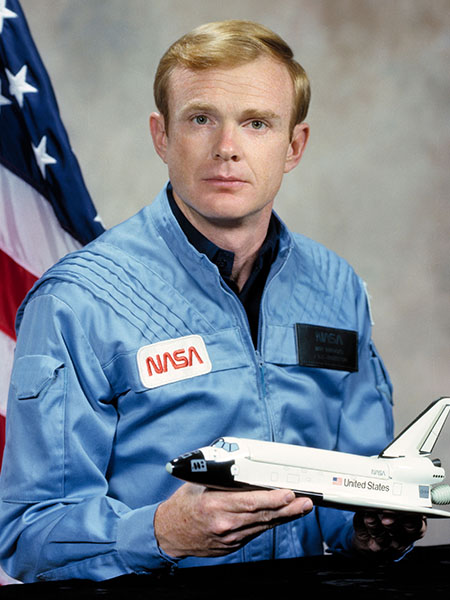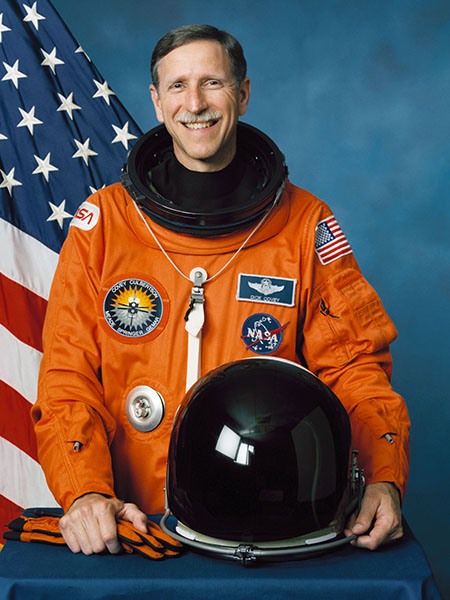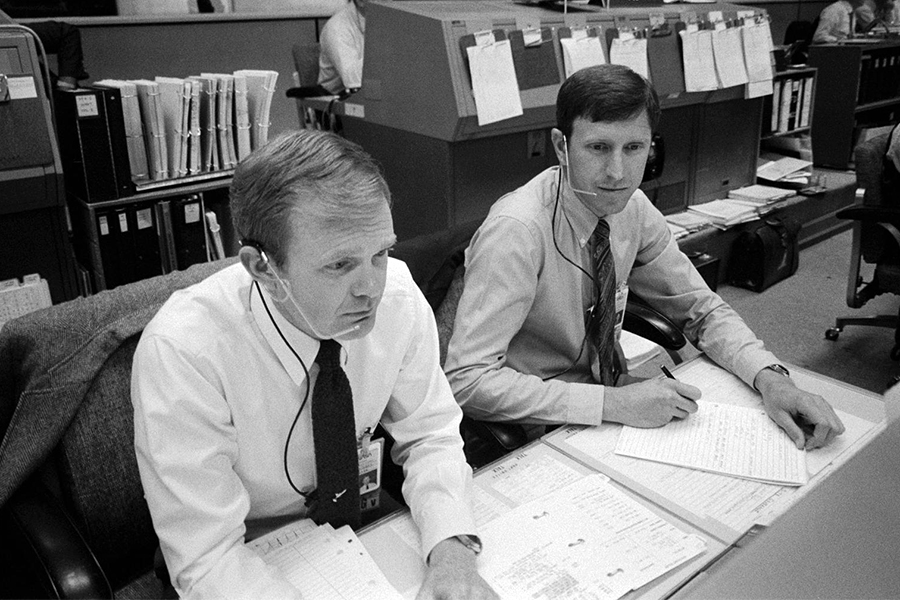'Astronaut program' important piece of School history
The opportunity was ideal.
A cooperative program that produced an accelerated master’s degree and allowed entrance into pilot training immediately following graduation.
When the United States Air Force Academy approached Purdue and its then-named School of Aeronautical and Engineering Sciences in 1962 asking about the possibility of a new master’s degree specifically tailored for academy graduates, it was hoping to provide a unique program for its cadets interested in astronautics.
Roy Bridges Jr. knew it was perfect for him.
When he was still in high school, the Soviet Union successfully launched Sputnik I, NASA introduced its first astronaut class with the “Mercury Seven,” and Yuri Gagarin was the first human in orbit. Soon after Bridges had started at the Air Force Academy, John Glenn became the first American to orbit Earth.
“I had my eyes set on, in some way, joining this exciting adventure to open the space frontier,” Bridges said. “I wanted to be part of that. Let’s just put it frankly, too, a degree in astronautical engineering was kind of sexy at the time, given what I wanted to do.”

Purdue approved the program in December 1962, understanding it’d benefit from an influx of quality graduate students who came with advanced preparation and likely would go on to have impressive careers, said former professor W.A. “Gus” Gustafson, who advised several students in the program.
The Purdue-Air Force Academy cooperative program, which initially awarded a Master of Astronautics degree, provided quite the path to the skies — and beyond. It’s oftentimes referred to as the “astronaut program,” for good reason.
Seven graduates of the program went on to become astronauts: Bridges and John Blaha (Class of 1966), John Casper (1967), Loren Shriver (1968), Richard Covey (1969), Guy Gardner (1970) and Gary Payton (1972).
“The fact that we had the group from the academy plus our other students who eventually became astronauts sort of built our reputation in that field,” Gustafson said of the program, which continued until 1976. “Purdue uses the term ‘Cradle of Astronauts,’ and we certainly had quite a few, and right now we’re still right up among the top in number of students who have become astronauts among all the schools in the country. So we established a reputation in that respect, which I think has probably done some good to the University’s overall recognition of its value and interest.”
For those with astronaut aspirations, obtaining a master’s degree and accelerating entry into pilot training was essential. The degree amplified the resume — and provided prime preparation — and earlier pilot training meant getting into Test Pilot School sooner. The latter had a special significance.
“We all knew at that time that becoming a test pilot was a stepping stone to selection as an astronaut because almost all of the pilots that had been selected to become astronauts had gone to either the Air Force or Navy Test Pilot School,” Covey said.
“Six of the seven of us, if you look at what we did after we left Purdue, you can see a pretty common career path — went on to flight training, to Test Pilot School and then were eventually selected as pilot astronauts.”
The first group of 15 cadets accepted into the program started in June 1963. To get that far, cadets were required to take up to 15 hours of additional coursework, including six hours of graduate-level courses at the Air Force Academy, beyond what was required for a bachelor’s degree, and “test out” of basic freshman math courses, Covey said.

It was a competitive program, and Bridges and Covey insist many of their classmates who wanted to participate — who majored in astronautics at the academy, took the advanced courses and tested out on the math — didn’t make the cut.
A letter from General Robert F. McDermott of the Air Force Academy to then-Dean of Engineering George A. Hawkins in 1966 said 56 students were in competition for the 15 available slots that year and “this challenge has improved the quality of the work of the students involved.”
The master’s program modified its requirements over the years, eliminating a thesis after the first year, but it generally consisted of two summer courses, an accelerated one-month course in August and five courses in the fall to complete the degree.
The seven-month program had its challenges — an adjustment to civilian life after being on base for years, a required ‘B’ average and courses that “were difficult as hell,” Bridges said with a laugh.
“I didn’t know anything about Purdue before looking into this program,” Bridges said. “It was a highly-rated school, without a doubt. Clearly, the courses we took were very, very high quality.”
More than 50 years later, Bridges still hasn’t forgotten his first.
In the summer, while he still was adjusting to civilian life with roommate Blaha in their two-bed apartment at the Williamsburg on the Wabash and balancing spending time at a marina on a nearby lake with Purdue’s sailing club, Bridges took an electrical engineering course.
His first exam hit.
And Bridges scored a 21 percent.
“Fortunately for me, a lot of people made worse than that,” Bridges said. “So the instructor said, ‘I’m going to give you 10 pop quizzes spread out over the rest of the course, and I’ll substitute your grade on those 10 pop quizzes for that first big graded exam.’ So I used to have sweat dripping off of my fingers when I’d go into class until I found out we weren’t having a test that day.
“I dropped out of sailing or any other social activity.”
That test proved important in giving Bridges a barometer. He quickly learned the courses were well done, and the professors were demanding. So he locked in, building up proficiency through what he called repetitious practice, staying up until at least midnight every night to master what he needed to know — with time for little else.
“Our social life was zilch,” Bridges said. “That fall just about killed me. My mom was a nurse. I had to go to her to get some advice on a better diet to keep me from dying of a stomach ulcer before I got out of there.”
But Bridges did enjoy the courses and how they blended together in a way that made sense.
Covey felt the same.
As an aspiring astronaut from before entering the Air Force Academy, Covey saw the academy as a “path forward” and the Purdue piece of the path was “just richer.”
Even though his academy buddies were taking 60 days of graduation leave over the summer, Covey never regretted being immersed in summer school instead, realizing the value of earning his master’s in a short time and knowing he was going immediately to flight training afterward.
“The key to me was the tempo. ‘I’m here to get these courses done and get my degree.’ So my approach from that standpoint was very much along that line,” Covey said. “(I said) ‘I have to do this in that timeframe. I’m going to hit the books and do what have to do to be successful at this and get through it.’ ”
At the Air Force Academy, Covey took a 500-level Advanced Astronautics course and a graduate-level math course in probability. At Purdue, like most students in the program, he took a hypersonics course with Gustafson and also had courses in missile systems design, orbital mechanics and propulsion, among others.
“Not everybody that took astronautical engineering was doing it because they had aspirations to be an astronaut. At the time, it was a relatively new major, and the whole idea of engineering associated with space was growing,” Covey said. “Not everyone in the Purdue program went on to fly, and they knew they weren’t going to fly before pursuing their master’s degree at Purdue. So they might not have had the same longer view toward becoming an astronaut, but they looked at it as a field of study and, at that time, military application that was incredibly fascinating and new. I think that was the attraction to so many of us.
“If you look at the number of schools back in the early ’60s that even had astronautical engineering majors, it was relatively few. It was probably MIT, Purdue, a couple others. We were part of that wave of folks being able to pursue a major in an engineering field that was new, growing, very dynamic and on the leading edge.”
It didn’t take long for Bridges and Covey to realize the impact of their Purdue education after graduation.
Bridges called the pilot training courses “a snap.”
“It was like going back to grade school,” he said.
That allowed him to focus more time on actually preparing to fly, a key for someone who didn’t consider himself a natural pilot. While he was getting consecutive “fair” grades from his instructor, and fearing he would get washed out of training, Bridges was able to spend time “chair flying” instead of studying. He’d sit at a chair at the dining room table and imagine he had one had hand on the control yoke and another on the throttle, thinking about exactly how to perform maneuvers and mentally flying the plane. After his 10th ride, he scored an “excellent.”
“I was mentally way out in front of the airplane, and I could really focus in on the finer points of flying,” Bridges said. “What I found is that not only helped me pretty much ace the jet part of the training, but it made my transition into fighters really easy. It helped me survive Vietnam. When I got into Test Pilot School, obviously, now you’re a couple years downstream from Purdue and I’d picked up some study guides to refresh myself on math and different basics, and again at Test Pilot School I found that I could spend most of my evenings mentally preparing for my flights as opposed as having to study so much like I had to do at Purdue.
“So all of that rigorous academic training at Purdue really paved the way for me to excel in flying. Despite my lack of natural ability when I started flying, I graduated No. 1 in my Test Pilot School class, which meant I had the choice of the plum jobs coming out of Test Pilot School, which helped me later on as I was applying for astronaut training.”
Years after the Purdue program, Covey realized the applications, too. What he learned about propulsion in jet engines and rocket engines at Purdue was directly applicable during his flying and astronaut careers — “It was incredible, being able to rely back on that,” he said — and when he was making hypersonic re-entries on the Space Shuttle.
“There’s no question in mind that my master’s degree, the work I did at Purdue, prepared me to be a better student, a better pilot and a better astronaut,” Covey said.
Covey was selected as an astronaut candidate in January 1978 and completed training and became part of the corps in August 1979. He piloted four Space Shuttle flights, STS 51-I in 1985, STS-26 in 1988, STS-38 in 1990 and STS-61 in 1993. He logged 646 hours in space.
In 1979, Bridges and former roommate Blaha were working at the Pentagon together and applied for NASA’s astronaut class for the second time — they weren’t selected for the Class of 1978. But in 1980, both were selected. Bridges piloted the Space Shuttle Challenger on mission STS-51F in 1985.
Select Seven
John Blaha (MS ’66): Selected as NASA astronaut in May 1980, Blaha logged 161 days in space on five space missions. He served as pilot on STS-33 and STS 29, was Spacecraft Commander on STS-58 and STS-43, served on Mir-22 as Board Engineer 2, and was a Mission Specialist on STS-79 and STS-81.
Roy Bridges Jr. (MS ’66): Selected as NASA astronaut in May 1980, Bridges piloted the Space Shuttle Challenger on mission STS-51F in July 1985.
John Casper (MS ’67): Selected as NASA astronaut in May 1984, Casper became an astronaut in June 1985. A veteran of four spaceflights, he logged over 825 hours in space. He was the pilot on STS-36 (1990) and commander on missions STS-54 (1993), STS-62 (1994) and STS-77 (1996).
Loren Shriver (MS ’68): Selected as NASA astronaut in January 1978, Shriver was a veteran of three space flights and logged more than 386 hours in space. His missions include STS-51C in 1985, STS-31 in 1990, and STS-46 in 1992.
Richard Covey (MS ’69): Selected as NASA astronaut in January 1978, Covey became an astronaut in August 1979. A veteran of four space flights, STS 51-I in 1985, STS-26 in 1988, STS-38 in 1990 and STS-61 in 1993, Covey logged over 646 hours in space.
Guy Gardner (MS ’70): Selected as NASA astronaut in May 1980. Gardner’s missions included STS-27 in 1988 and STS-35 in 1990.
Gary Payton (MS ’72): Flew as payload specialist on STS-51C Discovery in 1985, the first dedicated Space Shuttle Department of Defense mission. At the conclusion of the mission, Payton had traveled over 1.2 million miles in 48 Earth orbits, and logged more than 73 hours in space.

